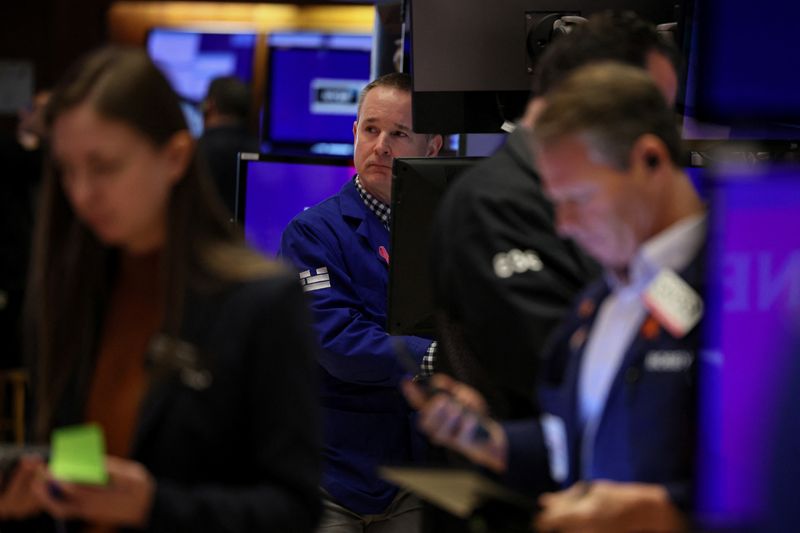By Lewis Krauskopf
NEW YORK (Reuters) - Soaring U.S. Treasury yields are further boosting the appeal of bonds over stocks, deepening an already painful equity selloff while threatening to weigh on equity performance over the long term.
Bond yields near historic lows bolstered the attractiveness of stocks over the past 15 years, when the U.S. Federal Reserve kept rates near zero to support the economy following the 2008 financial crisis.
This year’s climb in Treasury yields is changing that calculus, as government bonds offer income that is viewed as risk-free to investors who hold them to term. The yield on the benchmark 10-year U.S. Treasury - which moves inversely to bond prices - hit 5% earlier this week, its highest level since 2007, in a climb fueled by hawkish Fed policy fears and fiscal worries.
As a result, many investors are recalibrating how big of a role stocks should play in their portfolios. Fund managers have been overweight bonds for eight out of 10 months of 2023 and are currently above their average historical allocation, the latest survey from BofA Global Research showed. At the same time, they are underweight stocks.
The latest spurt higher in yields, which began this summer, has taken its toll on stock investors. Although the S&P 500 is up about 9% for the year, it has slid over 8% since late July, when it peaked for the year. The 10-year Treasury yield has climbed about a full percentage point since then.
“It isn’t as if we have never had 5, 5.5% - that was the norm. What is difficult for the market is that has not been the norm for many years,” said Quincy Krosby, chief global strategist for LPL Financial (NASDAQ:LPLA). “The market is having to adjust to a new calculus.”
Rising bond yields raise the cost of capital for companies, threatening their balance sheets. Tesla (NASDAQ:TSLA) CEO Elon Musk said last week that he was concerned about the impact of high interest rates on car buyers.
At the same time, companies’ projected future profits are more heavily discounted in analysts’ models when bond yields rise, as investors can now get a higher reward from risk-free government debt.
Meanwhile, the equity risk premium (ERP), which typically pits the S&P 500's earnings yield against the 10-year Treasury yield to determine equities' relative attractiveness, recently stood at 30 basis points, compared with a 20-year average of about 300 basis points, according to John Lynch, chief investment officer at Comerica (NYSE:CMA) Wealth Management.
Historically, the S&P 500 has shown average 12-month returns of less than 6% when the ERP falls below its average, Lynch said. In contrast, when the market’s ERP surpasses that level, forward returns approach 12%.
Investors, as well as the Fed, have also eyed bond "term premiums" as another factor pushing yields higher. The term premium is the added compensation investors expect for owning longer-term debt and is measured using financial models. It currently stands at its highest level since 2015 at just below 0.5%.
Low bond term premiums have been supportive of lofty equity valuations for most of the last decade. Stocks have averaged a forward price-to-earnings ratio of 17.8 over the last 10 years, while the term premium has averaged -0.3%. That compares with a historical average forward P/E of 15.6 and a term premium of 1.4% since 1985.
Current equity valuations also may be banking on overly optimistic earnings estimates, if the higher interest rates slow the economy as many analysts expect.
As it stands, S&P 500 companies are expected to increase earnings by 12.1% in 2024, according to LSEG IBES.
“If we have really prohibitively high interest rates, it is going to be hard to hit that target,” said Matthew Miskin, co-chief investment strategist at John Hancock Investment Management.
John Hancock Investment Management is recommending a modest overweight to bonds. Similarly, LPL Financial also is recommending a modest overweight to fixed income.
Despite the rising rates, some investors said stocks can remain resilient.
Analysts at UBS Global Wealth Management said in a note this week that the level of the equity risk premium "does not look alarming," noting the level was even lower from 1980 to 2000.
Meanwhile, the 10-year yield averaged 6.2% from 1950 to 2007, a period that saw the S&P 500’s annualized compounded return at 11.9%, according to Keith Lerner, co-chief investment officer at Truist Advisory Services.
“My message would be don’t get overly negative on equities just because you have more competition from cash and Treasuries, because that is historically the norm,” Lerner said.
